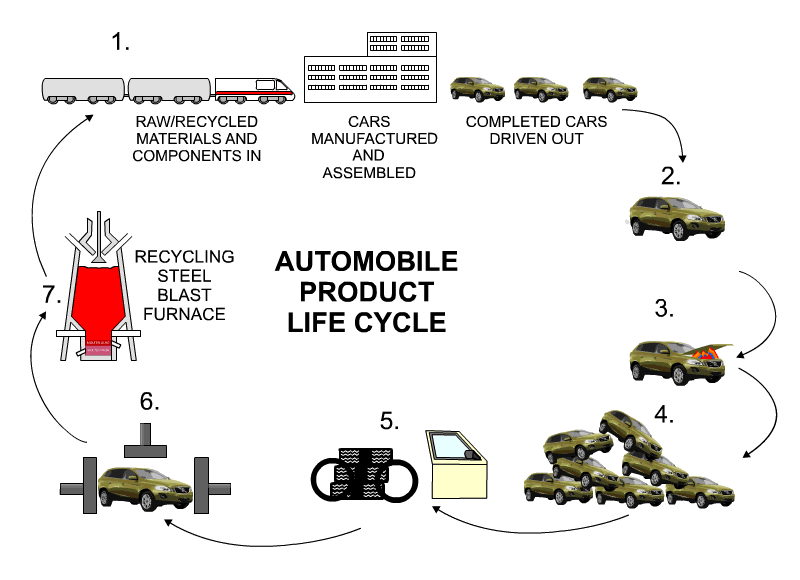| CLICK HERE FOR INDEX PAGE | |
| PRODUCT LIFE CYCLE - HOW THIS INFLUENCES CAR DESIGN AND MANUFACTURE - ENVIRONMENTAL FACTORS |
|
| V. Ryan © 2010 | |
| PDF FILE - CLICK HERE FOR PRINTABLE WORKSHEET | |
|
ENVIRONMENTAL FACTORS AUTOMOTIVE DESIGNERS CONSIDER WHEN DESIGNING THE LIFE CYCLE OF A CAR |
|
|
The entire life cycle of the car must be considered by automotive
designers, as it is demanded by customers and by legal constraints imposed
by governments and trading organisations, such as the EEC. Car manufacturers such as Volvo, are committed to the design and manufacture of cars, that have a minimum environmental impact. A major consideration of a car designer, is how a potential customer will use the car after it has been manufactured, and its associated environmental consequences. For this reason, extremely fuel efficient cars engines are now available. Car designers also consider design constraints, one being, determining the most energy efficient and environmentally friendly methods of manufacture. Designers must also plan, how materials and components from the car, can be recycled/reused after the car eventually stops working and is scrapped. |
|
 |
|
| THE LIFE CYCLE OF A TYPICAL CAR | |
|
1. Raw materials, recycled materials and components enter the factory at
one end of the enormous Manufacturing facility. Volvo transport their raw
and recycled materials by train, reducing CO2 emissions as trucks are not
required. Modern efficient equipment and industrial processes are used
throughout the entire manufacturing process. Completed cars are driven out
of the opposite end and transported to their owners. 2. The car is driven throughout its useful life time. Energy efficient engines have been designed and developed to reduce pollution and Co2 emissions. Efficient engines require less fuel, saving the customer money and reduces negative effects on the environment. Quality control of components and the use of computer controlled machinery, ensure that a minimum of repairs are necessary throughout the life time of the car. 3. Eventually, the car breaks down for the last time and recycling / scrapping is necessary. 4 and 5. Up to 85% of the parts/components and materials of Volvo cars can be recycled, with many components recovered for reuse. Materials such as steel, rubber and plastics and glass are reclaimed. 6. The steel body is crushed to a standard size, enabling easy storage and transport. The reclaimed steel is sent to the steel mill. Volvo use their scrap train, saving the use of trucks, contributing to the reduction in their overall carbon footprint. 7. New iron is processed with recycled steel, in a blast furnace. The resulting steel is processed in the rolling mill and steel sheet is the result. This is sent to the car manufacturing plant. Using recycled materials is environmentally friendly and reduces the cost of manufacturing each car, saving the customer money. |
|
| VOLVO’s XC60 - A MEMBER OF THE DRIVe SERIES | |
 |
|
| Volvo’s XC60 is one in a series of cars, designed with its entire life cycle being a key consideration. It has been manufactured, with a high proportion of recycled steel and plastics. It is designed to be extremely reliable, keeping maintenance costs down. This also helps reduce the environmental effects of driving. A reliable car needs less replacement parts, reducing the need to manufacture as many parts / components. This means that raw materials are conserved as well as the energy needed to power machines on the mass production line. The XC60 is one of Volvo's DRIVe series of cars, aimed at reducing carbon emissions, throughout its life cycle. | |
| CLICK HERE FOR PRODUCT DESIGN INDEX PAGE | |